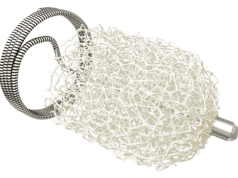
The use of hypnosis during endovascular aneurysm repair (EVAR) may improve haemodynamic and respiratory stability and allow faster patient recovery, according to a presentation given at the 2016 VEITHsymposium (15–19 November, New York, USA).
Jean-Pierre Becquemin, Hôpital Henri Mondor, Paris, France, told the VEITHsymposium audience that hypnosis in combination with local anaesthesia should be considered in the larger context of the move towards less invasive treatment techniques in vascular surgery. He suggested that hypnosis, by reducing patient anxiety, discomfort and unrest, could thus reduce the risk of treatment failure.
A “psychic disassociation of mind and body,” hypnosis can theoretically allow a patient to disconnect from the pain and discomfort associated with surgery, Becquemin said, without the use of drugs. In implementing the treatment, he explained that preoperative evaluation should take place to identify “receptive patients, with whom a comfortable, reassuring and peaceful patient environment is defined”. Intraoperatively, the patient should be helped to “reach the best relaxed state of mind,” Becquemin said. This means, he explained, “empathy from those in the operating room, with positive and reassuring words, a quiet a slow speech rate and deep, quiet breathing.” Becquemin also suggested the use of oral or physical suggestions to divert sensations from external stimuli. During the hypnosis, Becquemin also noted that it is important to maintain communication with the patient using signalling, as intensification of hypnosis with the patient’s participation may be required.
“There is already proof that hypnosis affects these mechanisms,” Becquemin told the audience, pointing to scientific papers that have used magnetic resonance imaging to examine the effect of hypnosis on mental activity. Becquemin pointed to a 57-patient 2016 study (Jiang et al, Cereb Cortex) that reported decreased dorsal anterior cingulate activity and reduced connections between the dorsolateral prefrontal cortex and the medial prefrontal and posterior cingulate cortex.
This was supported by the findings of a paper published in 2011 (Demertzi et al, Prog Brain Res), which indicated that hypnosis resulted in reduced lateral frontoparietal connectivity, increased bilateral angular and middle frontal gyri, and decreased posterior midline and parahippocampal connectivity.
Becquemin and colleagues, focusing specifically on the potential of hypnosis in vascular surgery, conducted a prospective single-centre evaluation involving 32 consenting EVAR patients, separated into two groups; Group 1 treated under hypnosis and local anaesthesia of the groin, and Group 2 treated under general anaesthesia. Technical success was 100% for both groups, while procedure duration was slightly shorter in Group 2 (122 minutes vs. 148 minutes for Group 1). Pain scores, recorded in recovery, was 6/10 in Group 2 compared with only 1/10 in Group 1. The most commonly-reported comfort rating was “good” in Group 2, compared with “Excellent” in Group 1. The need for noradrenaline to relieve pain was also needed in 76.92% of Group 2 patients compared with 19.23% of Group 1 patients, and overall satisfaction was lower in Group 2 (75%) than Group 1 (100%). Furthermore, Becquemin noted that discharge was earlier for Group 1 (average of one day post-surgery) than in Group 2 (average of three days post-surgery).
Such a minimally-invasive approach to anaesthesia and surgery, Becquemin concluded, could therefore be beneficial for patients well-being both during and after EVAR, and could also improve team communication within the operating room.













